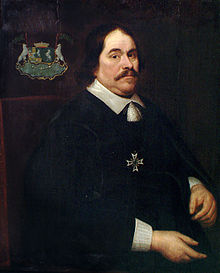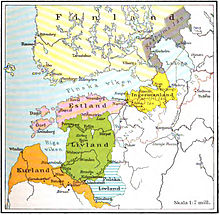Courland colonial history
The Duchy of Courland and Zemgale was the smallest European country that had colonies in America and Africa . The American colony existed in Tobago between 1654 and 1659 and then again from 1660 to 1689, an African colony on James Island between 1649 and 1660.
history
Courland in the 17th century
Courland became a duchy in 1561 , it was a fiefdom of the Polish-Lithuanian Rzeczpospolita in what is now Latvia . Courland only had about 200,000 inhabitants. The Germans made up the educated middle class and the commercial population. The Latvians were farmers.
Under Duke Jakob Kettler , the duchy rose to its greatest prosperity. It all started with a marriage: in 1645 Kettler married Luise Charlotte von Brandenburg (1617–1676), the eldest daughter of Elector Georg Wilhelm von Brandenburg . She added a very large fortune to her husband as a dowry and she was a shareholder in the Dutch West India Company . Using his wife's experience, the Duke began to moor harbors in Windau and Libau and ordered ocean-going ships from Dutch and German shipyards.
On the way to becoming a trading company in Courland
During his travels to Western Europe , Jacob became an avid advocate of trade. Metal working and shipbuilding were more and more developed. Trade relations were established not only with the immediate neighbors, but also with Great Britain , France , the Netherlands, Portugal and others. Kettler founded its own merchant fleet in Europe .
The Brandenburg-Courland colonies in the Caribbean
The future Duchess of Courland had already sent trade travelers from Brandenburg to the West Indies before 1637 . She commissioned 212 settlers and adventurers to found a colony in Tobago . An earlier European settlement, a Dutch colony founded in 1628, already existed on the island, but was attacked and wiped out by the Spanish after a few months.
The first Brandenburg-Courland colony was a failure, as was a second attempt in 1639. The third attempt began more promisingly in 1642. Two ships under the leadership of Captain Cornelius Caroon brought more than 300 settlers to the north coast near what is now Courland Bay founded a colony. But they too had to give up their establishment in 1650. a. as a result of resistance from the Caribbean locals.
New Kurland on the West African coast
The two ducal-Courland ships Walfisch and Krokodil undertook a trading expedition to the west coast of Africa in 1649 . The declared destination was to establish a trading post there too. It was founded on the river island St. Andrews Island in the Gambia River and called Sankt Andreas , it was the first place in New Courland . To protect the settlement, the construction of the Fort Jacob fortress began immediately .
Plans for whaling in the North Atlantic
The Duke commissioned the fleet, which had grown considerably in the meantime, with further trade expeditions. His ships visited the Faroe Islands and Iceland to negotiate bases or anchorages for whaling . Further expeditions were to penetrate into unexplored areas of the South Seas.
Another attempt at founding a company on Tobago
Soon after, on May 20, 1654, another attempt was made to found a colony in Tobago, where the ship The Duchess of Courland's coat of arms landed. The ship brought 45 cannons, 25 officers, 124 Courland soldiers and eighty families with it to take possession of Tobago. Captain Willem Mollens renamed the island again in New Courland . A fort was built in the southwest of the island: Fort Jacobus .
The fort was surrounded by the city of Jacobstadt (later Jamestown ). Other places were also given names related to the old homeland, such as Great Courland Bay, Courland Estate, Libau Bay and Little Courland Bay. A Protestant church was built by the Kurlanders in the first year of settlement. A second Dutch colony, Nieuw Walcheren , was founded in September 1654 and soon grew beyond the size of the Courland settlements. 120 colonists from Courland arrived in 1657 and the Dutch colony had a population of 1200 when 500 French settlers joined it.
The following goods were exported to Europe: sugar , tobacco , coffee , cotton , ginger , indigo , rum , cocoa , tortoiseshell , tropical birds and their feathers .
The end of Courland's independence
In the meantime, the power political situation in the Baltic Sea region had shifted. After the end of the Thirty Years' War , Sweden began to show more interest in its southeastern neighboring areas. In 1655 the Swedish army invaded the territory of Courland and laid the foundation stone for the Second Northern War . Duke Jacob was held captive by the Swedish army from 1658 to 1660.
Loss of the New Courland colony on Tobago

During this time the Courland bases were taken over by the Dutch, who were in the majority. The merchant fleet was hijacked and the factories were destroyed. The Dutch settlers on the island surrounded Fort Jacobus and forced Hubert de Beveren , governor of the Kurlanders, to surrender. Courland officially gave up New Courland on December 11, 1659. This war ended with the Treaty of Oliva of 1660.
The Courland administrators left Tobago in 1666, presumably after a pirate attack that same year. In 1668 a Courland ship attempted to retake Fort Jacobus, but was driven out by the Dutch. Parts of the island of Tobago were regained for a short time. This happened at the end of Jacob's reign with the attempt to found a new colony in July 1680, but this attempt also failed. He had the settlements and factories restored, commissioned the purchase of new ships, but the duchy never regained its former prosperity. The island of Tobago was without an administrator from March 1683 to June 1686 and therefore ownerless. The Courland rule on Tobago ended with the sale of the island to the Dutch. In May 1690 the last settlers left Tobago for good, unless they had defected to the Dutch. However, absent governors were appointed until 1795.
Governor of New Courland (Tobago)
| 1642-1643 | Edward Marshall |
| 1643-1650 | Cornelius Caroon |
| 1654 | Adrien Lampsius |
| 1656-1659 | Hubert de Beveren |
| 1660-1689 | Karl de Napp |
Web links
literature
- Edgar Anderson: The first Courland expeditions to the West Indies in the 17th century. In: Baltic booklets. Volume 8.1, 1961, pp. 13-35.
- Edgar Anderson: The Courland Colony of Tobago. In: Baltic booklets. Volume 8.1, 1961, pp. 216-232.
- Edgar Anderson: Senie kurznieki Amerikd un. Tobago kolonizacija [The ancient Couronians in America and the colonization of Tobago]. Stockholm 1970.
- Edgar Anderson: The Couronians and the West Indies. Chicago 1965.
- Alexander Berkis: The History of the Duchy of Courland (1561-1795). Towson 1969.
- Alexander Berkis: The Reign of Duke James in Courland (1638-1682). London 1960.
- Armin M. Brandt: Courland's colonies . In: history with a kick . Issue 7. Sailer Verlag, 1999, ISSN 0173-539X , p. 21 .
- Ulrich van der Heyden: Red eagles on Africa's coast. The Brandenburg-Prussian colony Großfriedrichsburg in West Africa. Selignow Verlag, 2001, ISBN 3-933889-04-9 , pp. 104 .
- Karin Jekabson-Lemanis: Balts in the Caribbean, The Duchy of Courland's attempts to colonize Tobago Island , 1638 to 1654, in: Caribbean Quarterly , Volume 46, No. 2, 2000, pp. 25-44. (chargeable)
- Otto Heinz Mattiesen: The colonial and overseas policy of the Courland dukes in the 17th and 18th centuries. (= Publication series of the city of Germans abroad 6) Stuttgart 1940.
- Otto Heinz Mattiesen: The colonial and overseas policy of Duke Jacob of Courland, 1640-1660 . Stuttgart 1939 ( online at archive.org ).
- Otto Heinz Mattiesen: Duke Jakob von Kurland and his politics. In: Pirmeis Lat-vijas Vēsturnieku Congress 1937 , pp. 427–434.
- Harry C. Merritt: The colony of the colonized: the Duchy of Courland's Tobago colony and contemporary Latvian national identity. In: Nationalities Papers. Volume 38, No. 4, 2010, pp. 491-508.
- Stefan Noack: The nightmare of the indigenous people - Kurland's colony on Tobago. GRIN Verlag, 2011. Preview of Google books
- Stefan Noack: The Duke's dream - Courland's colony on Tobago. GRIN Verlag, 2009. Preview of Google books
- Christoph Rella: In the beginning there was the fort. European fortification policy in Guinea and West India (1415–1815) Expansion - Fortification - Colonization . Self-published, Vienna 2008, p. 369 ( as digitized version [PDF; 7.6 MB ]).
- Imbi Sooman, Jesma McFarlane, Valdis Teraudkalns, Stefan Donecker: From the port of Ventspils to Great Courland Bay: The Couronian colony on Tobago in past and present . In: Journal of Baltic Studies , Volume 44, No. 4, December 2013, pp. 503-526.
Individual evidence
- ↑ Lennie M. Nimblett: Tobago. The union with Trinidad 1889-1899. Myth and reality . AuthorHouse, Bloomington 2012, ISBN 978-1-4772-3449-5 , p. 311.



